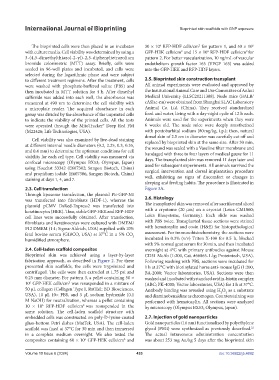Page 441 - IJB-10-6
P. 441
International Journal of Bioprinting Bioprinted skin scaffolds with GNP exposure
The bioprinted cells were then placed in an incubator 30 × 10 RFP-HDF cells/cm for pattern 1, and 50 × 10
6
6
2
with culture media. Cell viability was determined by using a GFP-HEK cells/cm and 15 × 10 RFP-HDF cells/cm for
2
6
2
3-(4,5-dimethylthiazol-2-yl)-2,5-diphenyltetrazolium pattern 2. For better vascularization, 10 ng/mL of vascular
bromide colorimetric (MTT) assay. Briefly, cells were endothelium growth factor 165 (VEGF 165) was added
seeded in 96-well plates and incubated, and cells were into the GFP-HEK and RFP-HDF layers.
selected during the logarithmic phase and were subject
to different treatment regimens. After the treatment, cells 2.5. Bioprinted skin construction transplant
were washed with phosphate-buffered saline (PBS) and All animal experiments were evaluated and approved by
then incubated in MTT solution for 4 h. After dimethyl the Institutional Animal Care and Use Committee of Anhui
sulfoxide was added into each well, the absorbance was Medical University (LLSC20211388). Nude mice (BALB/
measured at 490 nm to determine the cell viability with cASlac-nu) were obtained from Shanghai SLAC Laboratory
a microplate reader. The acquired absorbance in each Animal Co. Ltd. (China). They received standardized
group was divided by the absorbance of the unprinted cells food and water, living with a day-night cycle of 12 h each.
to indicate the viability of the printed cells. All the tests Animals were used for the experiments when they were
were operated through the MitoTracker® Deep Red FM 6 weeks old. The nude mice were deeply anesthetized
(M22426; Life Technologies, USA). with pentobarbital sodium (80 mg/kg, i.p.); then, natural
dorsal skin of 2.5 cm in diameter was carefully cut off and
Cell viability was also examined by live-dead staining
at different internal needle diameters (0.2, 2.25, 0.3, 0.35, replaced by bioprinted skin at the same size. After 30 min,
the wound was sealed with a Vaseline filter membrane and
and 0.4 mm) to determine the optimum conditions for cell bandaged with three to four layers of medical gauze for 11
viability for each cell type. Cell viability was measured via days. The transplanted skin was removed 11 days later and
confocal microscopy (Olympus BX53; Olympus, Japan)
using Hoechst 33342 (E607302; Sangon Biotech, China) used for subsequent experiments. All animals survived the
and propidium iodide (E607306; Sangon Biotech, China) surgical intervention and dorsal implantation procedure
staining at days 1, 4, and 7. well, exhibiting no signs of discomfort or changes in
sleeping and feeding habits. The procedure is illustrated in
2.3. Cell transfection Figure 3A.
Through liposome transfection, the plasmid PE-GFP-N1
was transfected into fibroblasts (HDF-1), whereas the 2.6. Histology
plasmid pCMV DsRed-Express2 was transfected into The transplanted skin was removed after sacrifice and sliced
keratinocytes (HEK). Thus, stable GFP-HEK and RFP-HDF with a cryotome (20 μm) on a cryostat (Leica CM1860;
cell lines were successfully obtained. After transfection, Leica Biosystems, Germany). Each slide was washed
fibroblasts and keratinocytes were cultured with DMEM/ with PBS twice. Transplanted tissue sections were stained
F12 DMEM (1:1; Sigma-Aldrich, USA) supplied with 10% with hematoxylin and eosin (H&E) for histopathological
fetal bovine serum (GIBCO, USA) at 37°C in a 5% CO assessment. For immunohistochemistry, the sections were
2
humidified atmosphere. incubated in 0.3% (v/v) Triton X-100 for 0.5 h, blocked
with 5% normal goat serum for 30 min, and then incubated
2.4. Cell-laden scaffold composites overnight at 4°C with primary antibodies against Mouse
Bioprinted skin was achieved using a layer-by-layer CD31 McAb (1:200, Cat. #66065-1-lg; Proteintech, USA).
fabrication approach, as described in Figure 2. For these Following washing with PBS, sections were incubated for
presented skin scaffolds, the cells were trypsinized and 1 h at 37°C with biotinylated horse anti-mouse IgG (1:200,
centrifuged. The cells were then extruded at 1.75 psi and BA-2000; Vector laboratories, USA). Sections were then
0.25 mm diameter. For pattern 3, a pellet containing 50 × washed and incubated with standard avidin-biotin complex
2
6
10 GFP-HEK cells/cm was resuspended in a mixture of (ABC; PK-4000; Vector laboratories, USA) for 1 h at 37°C.
50 μL collagen (Collagen Type I, RatTail; BD Biosciences, Antibody binding was revealed using H O as a substrate
2
2
USA), 10 μL 10× PBS, and 3 μL sodium hydroxide (0.1 and diaminobenzidine as chromogen. Counterstaining was
M NaOH) for neutralization, whereas a pellet containing performed with hematoxylin. All sections were analyzed
10 × 10 RFP-HDF cells/cm was resuspended in the by microscopy (Olympus BX53; Olympus, Japan).
6
2
same solution. The cell-laden scaffold structure with
embedded cells was constructed on poly-D-lysine-coated 2.7. Injection of gold nanoparticles
glass-bottom Petri dishes (MatTek, USA). The cell-laden Gold nanoparticles (16 nm) functionalized by polyethylene
scaffold was fixed at 37°C for 30 min and then immersed glycol (PEG) were synthesized as previously described.
22
in a complete medium overnight. We also tested the The actual intravenous administration concentration
composites containing 60 × 10 GFP-HEK cells/cm and was about 253 mg Au/kg 5 days after the bioprinted skin
2
6
Volume 10 Issue 6 (2024) 433 doi: 10.36922/ijb.4692

